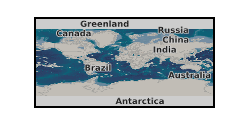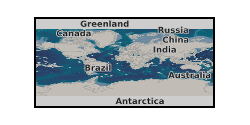Heriot Watt University
Type of resources
Topics
Keywords
Contact for the resource
Provided by
Years
Formats
Representation types
Update frequencies
Resolution
-

The dynamic characteristics of CO2 bubbles in Scottish seawater are investigated through observational data obtained from the QICS project. Images of the leaked CO2 bubble plume rising in the seawater were captured. This observation made it possible to discuss the dynamics of the CO2 bubbles in plumes leaked in seawater from the sediments. Utilising ImageJ, an image processing program, the underwater recorded videos were analysed to measure the size and velocity of the CO2 bubbles individually. It was found that most of the bubbles deform to non-spherical bubbles and the measured equivalent diameters of the CO2 bubbles observed near the sea bed are to be between 2 and 12 mm. The data processed from the videos showed that the velocities of 75% of the leaked CO2 bubbles in the plume are in the interval 25-40 cm/s with Reynolds numbers (Re) 500-3500, which are relatively higher than those of an individual bubble in quiescent water. The drag coefficient Cd is compared with numerous laboratory investigations, where agreement was found between the laboratory and the QICS experimental results with variations mainly due to the plume induced vertical velocity component of the seawater current and the interactions between the CO2 bubbles (breakup and coalescence). The breakup of the CO2 bubbles has been characterised and defined by Eötvös number, Eo, and Re. This is a publication in QICS Special Issue - International Journal of Greenhouse Gas Control, Nazmi Sellami et. al. Doi:10.1016/j.ijggc.2015.02.011.
-

Excel file containing the bubble measurement data. The dynamic characteristics of CO2 bubbles in Scottish seawater are investigated through observational data obtained from the QICS project. Images of the leaked CO2 bubble plume rising in the seawater were captured. This observation made it possible to discuss the dynamics of the CO2 bubbles in plumes leaked in seawater from the sediments. Utilising ImageJ, an image processing program, the underwater recorded videos were analysed to measure the size and velocity of the CO2 bubbles individually. It was found that most of the bubbles deform to non-spherical bubbles and the measured equivalent diameters of the CO2 bubbles observed near the sea bed are to be between 2 and 12 mm. The data processed from the videos showed that the velocities of 75% of the leaked CO2 bubbles in the plume are in the interval 25-40 cm/s with Reynolds numbers (Re) 500-3500, which are relatively higher than those of an individual bubble in quiescent water. The drag coefficient Cd is compared with numerous laboratory investigations, where agreement was found between the laboratory and the QICS experimental results with variations mainly due to the plume induced vertical velocity component of the seawater current and the interactions between the CO2 bubbles (breakup and coalescence). The breakup of the CO2 bubbles has been characterised and defined by Eotvos number, Eo, and Re.
-
The dataset consists of results of the electrochemical circle fit of the Nyquist plot generated by NOVA software to measure the Charge Transfer Resistance (RCT). Data demonstrates the curve of real and imaginary resistance against charges transmitted in the media of the carbon electrode biosensor. The change in RCT can detect the presence of the targeted antimicrobial resistance (AMR) DNA. The experiments were conducted by immersing the sensor's electrode in different concentrations of the target AMR DNA to determine the limit of detection. Full details about this nonGeographicDataset can be found at https://doi.org/10.5285/6bc69e2a-c771-4538-832e-2f6824b63474
-

The North Sea Interactive (NSI) project was an 8-month NERC funded project led by Heriot-Watt University, in collaboration with the BGS and NOC. The aim of the project was to develop a new decision-support tool that would translate existing marine environmental data into an interactive mapping product for the offshore oil and gas industry. The objectives of the project were achieved through the integration of the North Sea Benthos database (UKBenthos) with NERC's regional North Sea marine sediment data (BGS) and layers of modelled hydrodynamics (NOC). Aligning the biological, chemical, geological and hydrodynamic datasets in a single GIS product provides the oil industry and government regulators with a practical means of accessing this important archive of environmental data. The North Sea Benthos database (UKBenthos) was developed by Heriot-Watt University on behalf of UKOOA (now Oil and Gas UK) in the 1980s. Alongside macrobenthos, the database includes sediment properties, concentrations of aromatic compounds, total oil and metals. It currently includes data from 1975 to 2011 from 237 platforms and is continually being updated as new survey results are received by Oil and Gas UK.
-
Data comprise soil temperature, air temperature, soil volumetric moisture content, relative humidity, and surface wetness data from Onset Microstation Data Loggers at five locations (within the main vegetation types) at SikSik creek catchment, Trail Valley Creek, NWT, Canada. The data were collected under Project HYDRA, a NERC funded UK research project linking Heriot Watt University, the Universities of Durham, Aberdeen and Stirling, and the Centre for Ecology & Hydrology (CEH), Edinburgh. Project HYDRA is part of the UK Arctic Research Programme. Project HYDRA studies sites in Arctic Canada to investigate the biological, chemical and physical controls on the release of greenhouse gases from permafrost into melt water and to the atmosphere and how these emissions will influence global warming. Full details about this dataset can be found at https://doi.org/10.5285/10839b38-cc29-4a07-999a-ac32e3f70609
 NERC Data Catalogue Service
NERC Data Catalogue Service